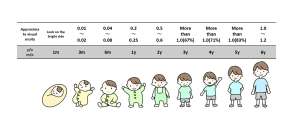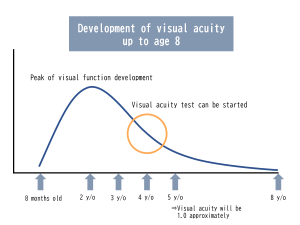Types of amblyopia are classified into the following four categories according to cause.
・Refractive Amblyopia
・Anisometropic amblyopia
・Strabismic amblyopia
・Deprivation amblyopia
The difficulty in treating amblyopia is excluding other eye diseases. Therefore, it’s difficult to determine that a child has amblyopia until the child reaches age of 4, when vision tests can be performed.
Amblyopia diagnosis is done comprehensively, including refraction and strabismus tests. If a diagnosis of “high possibility of developing amblyopia” is made, preventive treatment is initiated.
Refractive Amblyopia
In eyes with severe refractive error, such as high hyperopia, high myopia, or high astigmatism, the retina is not in properly focused. This reduces the stimuli to the brain, which leads to amblyopia.
The most common type of refractive error in children is hyperopia. At birth, children are slightly far sighted which improves with age, but in cases of severe hyperopia, retina cannot be focused, which prevent children from developing normal vision. Similarly, strong astigmatism can also cause amblyopia.

Amblyopia is suspected from the following behavior.
・Squinting
・Approaching and looking objects at near
Amblyopia can also be detected at 3-year-old child’s health checkup or at medical checkup in school entrance.
Anisometropic Amblyopia
Anisometropic amblyopia occurs when visual development is impaired in one eye due to a significant difference in hyperopia, myopia, or astigmatism between the left and right eyes.
When there is a large difference in refractive power between the left and right eyes, anisometropic amblyopia is a visual impairment that occurs in the eye with the stronger refractive error. The eye that has difficulty seeing is less likely to be used, resulting in poor vision development and reduced vision.
Because vision development is impaired in only one eye, while the other eye’s vision develops normally, so there is almost no inconvenience to the child in daily life. Because of this, it’s difficult for parents to notice if their children having difficulty seeing when they observe them.
However, it’s usually picked up during a visual acuity and refraction tests where one eye is tested at a time. There are many cases of amblyopia being detected during 3-year-old and school age health checkups.
Strabismic Amblyopia
Strabismus is a condition in which one eye looks straight ahead but the other eye looks in a different direction. The strabismic amblyopia occurs because the misaligned eye, called the strabismic eye, doesn’t see the object using their central part of retina, and therefore visual acuity doesn’t develop.
Because it’s unilateral amblyopia, the vision in the fixating eye is often good and can be determined by a visual acuity or refractive examination. In cases of mild strabismus, the eye deviation may not be apparent. Therefore, if the visual acuity test results aren’t good in only one eye, a detailed examination is performed to determine whether the patient is using their central vision or not. Strabismic amblyopia can co-exists with anisometropic amblyopia.
Deprivation Amblyopia
If light stimuli cannot reach the retina, vision will not develop. The main causes are drooping eyelids (ptosis), clouding of the surface of the eye (corneal opacity), and cataracts.
Deprivation is a condition that prevent the light stimulus from reaching the retina. Sometimes surgery is needed to remove causes that are interfering with the retina’s ability to receive stimuli.
In addition to diseases, there are also known cases of amblyopia caused by using only one eye for a while, for example, with an eye patch.





